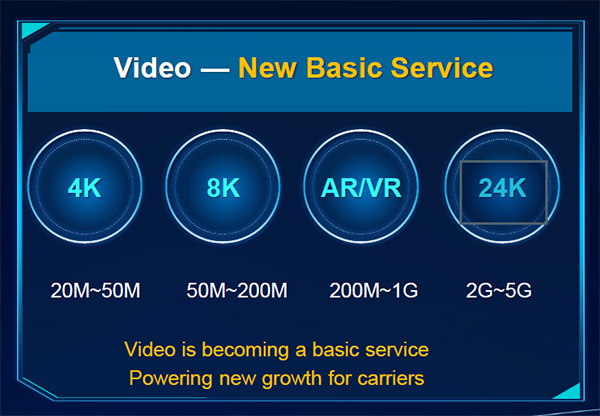5G: Someone is already talking about 24K video
At the dawn of 4G there was talk of 4K video, and it seemed like an unattainable thing: today we all have Netflix in our pocket. Preparing the way for the 5G Huawei already seems to have 24k video streams in mind.
I have to confess it: every time I heard about it, almost ten years ago, at the dawn of 4G technology, video 4K, I always had a smile. Those were times when looking at a mobile phone video VGA (640×480 pixels, at that time already considered a ‘high’ resolution) was a titanic enterprise and see among the future trends that of video 4K streaming mobile seemed an unrealistic forecast.
Well, over the years the technology has evolved, the terminals have changed and these changes have been a fertile ground for the creation of unpublished services, such as Netflix and the like, services that now represent a daily reality for many, but that only a few years ago they were not at all obvious.
When during the presentation of Ding Yun (Ryan Ding) Executive Director of the Board, President of Carrier Business Groups, Huawei Technologies, during the Pre-MWC conference held for journalists and analysts in London, I saw the writing 24K appear in the video trends for the future, I squinted to make sure you understood well.
 The slide is clear and not only draws a forecast of what will be in the future the demand for video content, but also details its weight in terms of data traffic. For streaming a 4K data stream you need 20-50Mbps connections, for the 8K streams, it will need 50-200, reaching up to the Gigabit connections required for virtual reality and augmented reality. The requirements of a 24K video stream, so heavy as to require a connection from 2 to 5 Gbps, are unattainable at the moment.
The slide is clear and not only draws a forecast of what will be in the future the demand for video content, but also details its weight in terms of data traffic. For streaming a 4K data stream you need 20-50Mbps connections, for the 8K streams, it will need 50-200, reaching up to the Gigabit connections required for virtual reality and augmented reality. The requirements of a 24K video stream, so heavy as to require a connection from 2 to 5 Gbps, are unattainable at the moment.
To the question ” What do we do with so many video resolutions? ” the answers can be multiple. On the consumer side, just think of how to land the Netflix in Italy with 4K, some residential users to enjoy the highest resolution on their UHD TV had to rely on soap bars 4G because the copper ADSL network could not meet the minimum requirements of band.
In reality, the B2B sector is one in which high resolution will play a key role, as we already mentioned in the article, you find at this address. The simplest example is video surveillance: just imagine many surveillance cameras that look different points at a single 8K wide-angle camera, whose frame is divisible into 16 Full HD streams, being able to replace the same number of cameras or, seen in another way, to offer a digital zoom equal to what would have a focal HD camera 16 times longer (but keeping the recording of all the rest of the information around). If we replace 24K at 8K, we can easily imagine the flexibility of a system of this magnitude.
Of course today is something unthinkable, as was the idea of 4K video on a mobile phone in 2009, but the evolution of technology and services have now accustomed us to being amazed at the speed of growth and adoption. There are other interesting issues that emerged from the event, including an interview on the theme of 5G, continue to follow us in the coming days to get the full picture.

